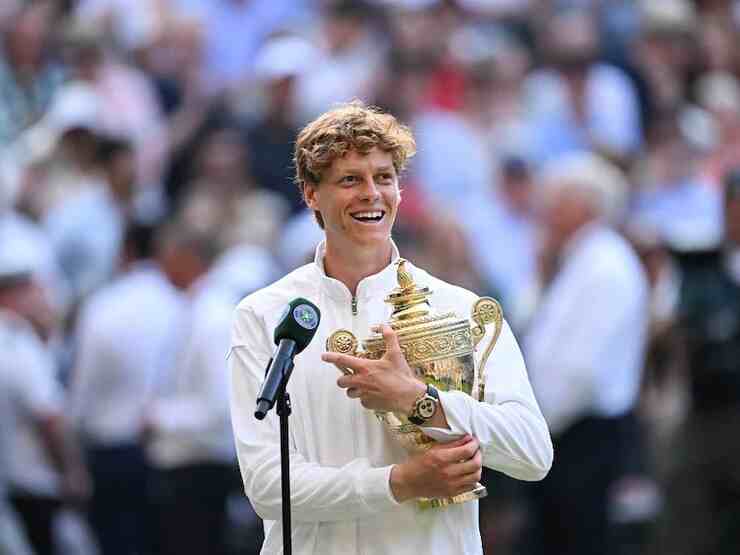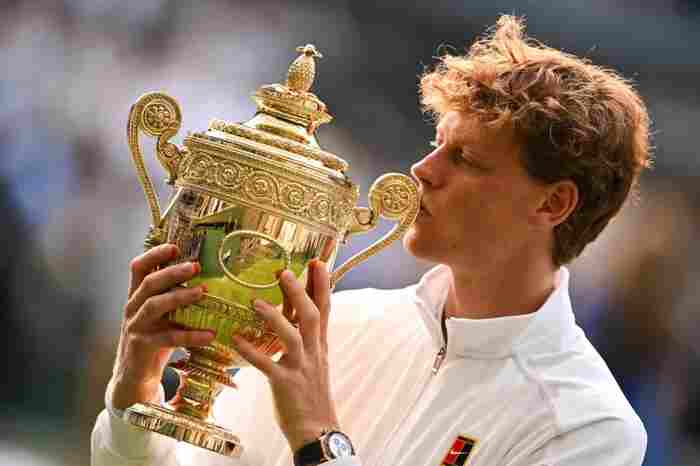🎾 That Iconic £3 Million Check Is Deeper Than It Looks
Wimbledon Wealth Unfiltered: When Jannik Sinner raised the Wimbledon 2025 trophy on July 13, the headlines proclaimed, “…he nets £3 million!” But here’s the twist: tax and fees drastically reduce what hits his bank.
Why this matters:
- Wimbledon set a record £53.5 million prize pool, with champions receiving £3 million—a solid 11% increase from 2024.
- But a 20% UK withholding tax slashes part of that immediately , and effective tax rates climb to 35–45%, leaving winners with a rough net of £1.7–2 million .
That £3M cheque is simply the “gross glamour.” The real story lies in strategic residency, brand partnerships, and intentional financial choices—decisions that shape champions beyond the match stats.
1. 🧠 Why This Matters
- Winning big only counts if you keep a meaningful portion—what remains often funds training, legacy efforts, or retirement safeguards.
- Athletes like Sinner, Świątek, and Alcaraz build careers with clear financial foresight—choosing homes and deals that reflect more than status.
- Fans and sponsors, understanding actual earnings, can appreciate why brands partner with values-forward athletes and why location matters.
2. 📚 Wimbledon 2025: What This Guide Will Reveal
Also, You’ll discover:
- The exact prize distribution from champion to early-round exits.
- How UK taxes radically adjust headlines.
- Why top talents choose Monaco, Spain, or Poland.
- Detailed net-earning breakdowns for Sinner, Alcaraz, and Świątek.
- How champions invest their earnings in causes, careers, and the future.
- The wider impact—for fans, sponsors, and tennis as a whole.
From headline hype to heartfelt reality, this guide shows what champions truly earn—and invest.
2. Prize Breakdown & Tax Reality: How Wimbledon Money Flows
2.1 A Record‑Setting Purse—but the Reality Behind the Numbers
Recommended by Nova News:
First of all, Wimbledon 2025 boasts a historic £53.5 million total prize fund, marking a 7% increase over 2024—doubling the prize pot from a decade earlier. Notably, both men’s and women’s singles champions take home £3 million each—an 11.1% increase from last year.
Here’s the round-by-round singles prize structure:
| Round | Prize (GBP) |
|---|---|
| Winner | £3,000,000 |
| Runner-up | £1,520,000 |
| Semi-finalist | £775,000 |
| Quarter-finalist | £400,000 |
| Round of 16 | £240,000 |
| Round of 32 | £152,000 |
| Round of 64 | £99,000 |
| Round of 128 | £66,000 |
The first‑round payout—though much less headline‑worthy—is up 10%, helping support up-and-coming players.
2.2 Tax Withholding: The First Cut
Before champions even see a cheque, 20% is withheld under UK tax law World Economic Forum. That means a £3M gross turns into £2.4M taken home briefly—with more adjustments to come.
Even those eliminated early are affected. For instance, first-round players lose £13,200 immediately, and still enter a tax bracket pushing total rates near 40%.
2.3 The Hidden Tax: Beyond the Withholding Rate
Also, understand this: that flat rate doesn’t mean final payment. Additional income tax and national charges apply, bringing effective rates to 35–45% for top earners .
So, champions who see £2.4M post-withholding may end up with only £1.7–2M after full tax—sometimes less, depending on deductions.
2.4 First-Round Players: Big Loss for a Small Win
In addition, consider a player who exits in the first round at £66,000 gross. After 20% withholding and bracket tax, they might net less than £40,000. That’s still substantial—but noticeably less than face-value numbers suggest .
2.5 Wimbledon 2025: Why Net Figures Matter More Than Gross
- A £3M cheque is a headline magnet—but champions understand what they actually walk away with.
- Sponsors look at net earnings when negotiating contracts.
- Coaches, parents, and players plan careers and budgets based on real cash flow—not just big numbers on paper.
✅ Takeaways
- Gross prize pool(£53.5M) and champion payouts (₤3M) grab headlines—but neglect tax and costs.
- 20% UK withholding plus bracket tax means champions net ~£1.7–2M.
- Even low-round players earn much less after deductions.
- Net vs gross is the crucial distinction for all stakeholders—players, sponsors, and fans alike.
3. Wimbledon 2025 | Residency Strategies & Net Earnings: The Champions’ Edge
To truly grasp Wimbledon net earnings 2025, it isn’t enough to look at paycheck headlines. Where a player lives—Monaco, Spain, or Poland—fundamentally shapes what they keep.
🏠 3.1 Monaco: The Tax Haven for Tennis Elites
But, Jannik Sinner, along with many ATP top‑ten players, resides in Monaco, a sovereign principality without personal income or capital gains tax.
- 2020 onward, Also, Sinner has lived and trained there for financial efficiency and proximity to European tournaments.
- Monaco residency requires property purchase or lease, bank deposit of €500k+, and at least 3 months of residency .
- Community opinions vary: many fans see it as smart strategy, others criticize champions for evading homeland contributions .
Still, champions like Djokovic, Tsitsipas, and Zverev follow the same tax-residency path.
These choices translate to:
- £3M gross taxed only at source (20% UK), giving Sinner a near-£2.3M net win.
- No additional Italian taxes, contrasted with peers in Europe, who pay double.
🇪🇸 3.2 Spain: The High‑Tax Home of Alcaraz
Carlos Alcaraz, Spain’s golden boy, chooses national roots—and national taxes:
- Spain’s combined national and regional income tax reaches 45–47%.
- Alcaraz pays 30% withholding in host countries like France (Roland Garros), then Spain taxes remaining amounts—with credit to avoid double taxation.
- Effective rate on Grand Slam prize money often exceeds 45%.
That means:
- On a £3M win, he nets approximately £1.7–1.8M, after dual taxation.
- Yet, with endorsement earnings (~$32M in 2024), even post-tax income remains in eight figures.
🇵🇱 3.3 Poland: Świątek’s Embrace of Patriotism Over Tax Savings
Iga Świątek remains firmly based in Poland, a choice driven by national pride and personal values over optimization.

- Poland taxes global earnings but provides credit for UK taxes.
- She ends up paying less than Spain but more than Monaco-based counterparts—netting around £1.9M after taxes.
Her grounded residency enhances authenticity with fans and drives value to local Polish sponsorships—offering lasting loyalty rather than net-worth boosts.
🧩 Wimbledon 2025: Summary Table of Residency-Adjusted Net Winnings
| Player | Residence | Gross Prize | UK Withholding | Local Tax | Approx. Net |
|---|---|---|---|---|---|
| Sinner | Monaco | £3M | £600k | £0 | £1.8–2M |
| Alcaraz | Spain | £3M | £600k | ~£650k | £1.7–1.8M |
| Świątek | Poland | £3M | £600k | ~£500k | ~£1.9M |
💡 Strategic Insights
- Tax-efficiency matters: Nearly half of a champion’s net depends on residency.
- ROI for sponsors: A £1.9M net winner is more impactful than a gross figure suggests.
- Athlete decision-making: Residency reflects deep financial planning, not just privilege or luxury.
✅ Coming Up Next
- 🧾 Player-by-player breakdowns of net earnings, endorsements, and financial behavior.
- ❤️ How champions invest in legacy and societal impact.
- ⚙️ What fans, sponsors, and players can learn from these decisions.
How Champions Transform Net Winnings into Legacy
Let’s examine how Jannik Sinner, Iga Świątek, and Carlos Alcaraz translate their post-tax earnings into meaningful impact—creating a blueprint for a new generation of champions.
🤝 4.1 Jannik Sinner: From Prize Money to Global Foundation
A Strategic Residenc y, An Inspiring Mission
Residing in Monaco since 2020 gives Sinner a tax-efficient base—but it’s not just about savings. It’s about purpose.
A few months ago, he launched the Jannik Sinner Foundation, aimed at supporting youth through sports and education. The board includes high-profile names like Alex Vittur, Stefano Domenicali, and Luca Maestri—signaling seriousness and long-term ambition.
A r/tennis forum notes:
“Yup…support will go to people who contact them with a program of their own…It’s a charity after all.”
And according to France 24:
“The foundation will ensure…that both sports and education are more accessible to younger kids.”
Impact Beyond Tax Benefits
- Net benefit: By avoiding high taxes via Monaco residency, Sinner can channel more funds into his foundation.
- Emotional weight: Sinner dedicated the Wimbledon trophy to his aunt, honoring family and community roots.
- Community building: This approach strengthens his public image—not as an athlete escaping taxes, but pursuing purpose.
🧠 4.2 Iga Świątek: Using Influence for Mental Health & Culture
Poland as Heart, Endorsements as Voice
Choosing to remain in Raszyn near Warsaw, Świątek pays Polish taxes. Yet her integrity shines, turning fiscal costs into cultural significance.
Her financial standing:
- Estimated $25–30 million net worth, with ~ $40 million in career prize money and ~ $15 million in endorsements (On, Visa, Porsche, Rolex).
- Visa partnership partly funds her mental-health initiatives, which she cites as deeply personal.
Giving as a Core Value
- Donated to UNICEF Poland on World Mental Health Day, including 300,000 PLN (~$70,000) in 2023.
- Auctioned her rackets and gear, raising over €500,000 for Ukraine aid.
By blending presence, voice, and giving, Świątek builds a legacy rooted in empathy and authenticity.
💪 4.3 Carlos Alcaraz: Reinforcing a Vision of Excellence
While Carlos Alcaraz hasn’t launched a public foundation, his Wimbledon runner-up position—netting ~£1.7–1.8 million post-taxes—supports his work with top coaches, elite training, and global brand investments.
His commercial portfolio includes luxury and performance brands, reflecting his blend of athleticism and global presence.
✅ Summary Table: Earnings to Impact
| Player | Post-Tax Prize | Key Investments | Purpose & Legacy Focus |
|---|---|---|---|
| Sinner | ~£1.8–2 M | Youth/education foundation | Social impact via sports and opportunity |
| Świątek | ~£1.9 M | Mental health donations & Ukrainian aid | Positive influence and social leadership |
| Alcaraz | ~£1.7–1.8 M | Elite team & brand portfolio | Sustaining peak performance and market value |
🔍 Why It Matters
- Financial pragmatism: Residency choices fuel philanthropic or performance goals—not just tax savings.
- Purpose-led branding: Audiences choose athletes who give back—not just win trophies.
- Investor insight: Sponsors can better align with athletes forging emotional and social impact.
Wimbledon 2025: Philanthropy, Sponsorship & Modern Sports Culture
In 2025, sports aren’t just about victories. They’re about values, impact, and social voice—and tennis stars like Sinner, Świątek, and Alcaraz are at the forefront. Their actions echo far beyond courts, shaping fan expectations, brand strategies, and societal norms.
5.1 Athletes as Philanthropic Role Models
Across sports, elite athletes deploy prize income for greater causes:
- After winning, stars often donate winnings to mental health, education, or disaster relief—demonstrating responsibility and compassionate leadership.
- Social studies show athlete philanthropy includes key elements: awareness, engagement, and communication—boosting both outreach and accountability online.
Champions become influencers beyond sports—their acts reinforce public trust and create ripple effects in societal well-being.
5.2 Why Brands Are Investing in Values
The sports sponsorship landscape is booming, projected to surpass $144 billion by 2034. But today, winning hearts means aligning with values:
- Emotional alignment: Brands that support female sports, mental health causes, or youth development forge stronger bonds—think ELF Beauty sponsoring female wrestling for DE&I credibility.
- Cultural fit: Sponsorship works best when brands resonate with athletes and fans—meta-analysis confirms this “event-brand fit” drives deep consumer connection.
- ROI clarity: Modern sponsors demand measurable outcomes via fan engagement, awareness, and loyalty .
So in tennis, brands want more than a logo—they want champions whose values align with purpose-driven narratives.
5.3 Wimbledon 2025: Tennis Stars Amplify Impact Through Social Media
The real magic happens when athletes share their values digitally:
- Naomi Osaka’s activism prompted awareness on mental health and racial justice, earning support from Nike and Mastercard—rooted in real-life relevance.
- Sinner’s foundation posts amplify youth education stories, building emotional brand strength.
- Świątek’s mental health initiatives blend authenticity with visible action—raising tens of thousands—and deepening fan connections .
These efforts strengthen athlete-fan bonds and increase sponsor appeal.
5.4 Why This Matters for Fans, Sponsors & the Tennis World
✅ Take Time For Fans
- Champion generosity builds stronger emotional ties—and inspires action.
- Genuine values encourage fans to support athletes beyond the court.
📌 Find Real Sponsors
- Aligning with meaningful athlete initiatives—youth development, mental health, nationality—drives brand image and sales value.
- ROI now hinges on shared values, cultural relevance, and purpose-driven campaigns.
✅ Just Tennis Governance
- Living and training in tax-efficient locations like Monaco cuts athletes’ personal tax burden—enabling bigger philanthropic efforts.
- Tournament bodies may revise sponsorship models or offer better charity support to adapt to athletes’ growing societal roles.
📌 Wimbledon 2025: Summary Table: The Ecosystem of Impact
| Dimension | Why It Matters | Result for Stakeholders |
|---|---|---|
| Athlete Giving | Philanthropy builds social capital | Fans feel closer; brands gain loyalty |
| Brand Alignment | Fits with societal expectations | Authentic campaigns increase ROI |
| Digital Storytelling | Personal stories engage crowds | Fans and sponsors both win emotionally |
| Tax Residency | Strategic savings → capacity for giving | Athletes fund programs; tournaments adjust frameworks |
🔗 Wimbledon 2025: What You Should Do Now
- Share: Post champion stories on social channels. Inspire others.
- Sponsor Smart: Evaluate athlete partners based on values alignment, not just fame.
- Watch Carefully: Notice player advocacy on and off court—it’s part of their brand.
- Support Initiatives: Champion youth programs or mental health charities tied to players you admire.
🚀 Wimbledon 2025: Time for Conclusion
We’ve deconstructed the financial reality behind Wimbledon 2025—revealing that what seems like a £3 million payday is far more nuanced. From prize breakdowns and tax deductions to strategic residency and heartfelt giving, champions craft earnings and legacies deliberately.
🔑 Key Takeaways
- Gross vs. Net
- Wimbledon’s top war chest stands at £3 million, but after UK withholding and added taxes, champions retain approximately £1.7–2 million.
- Residency Shapes Outcomes
- Players based in Monaco, like Jannik Sinner, pay only the UK withholding—saving nearly half their prize.
- Those in Spain or Poland face double taxation, yet choose national loyalty or financial pragmatism.
- Real-World Use of Earnings
- Sinner’s foundation channels winnings into youth education.
- Świątek’s philanthropy supports mental health and Ukraine aid.
- Alcaraz invests in elite teams and top-tier training.
- Impact Beyond Business
- Donations, charity work, and national pride help shape athlete brands, influence fan loyalty, and spark sponsor interest.
- The New Sporting Culture
- Today’s tennis stars are purpose-driven icons—not just athletes. Their choices echo in communities, boardrooms, and social media feeds.
📣 What You Can Do Next
- Share this insight with sports fans and sponsors who may miss the depth behind headline figures.
- Support athlete-led causes connected to youth, mental health, or humanitarian efforts.
- Consider net-earning when planning careers—whether as a player, parent, coach, or sponsor.
✨ Wimbledon 2025: Final Thoughts
Athletic greatness goes beyond point tallies and trophies—it’s measured in intentional impact, strategic planning, and ongoing legacy. As fans, investors, and change-makers, we see now that true champion behavior evolves from purpose, not just purse.
📨 Your Final Chance
Loved this deep dive into athlete earnings and impact?
✅ Subscribe to receive exclusive behind-the-scenes breakdowns of sports, finance, and legacy building.
✅ Share this article to spark conversations around what it really takes to win—and give back—at the highest level.

